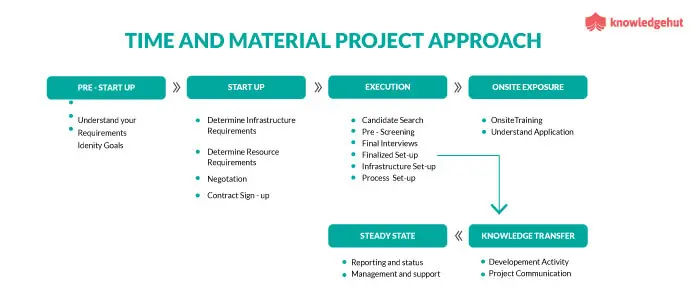- Blog Categories
- Project Management
- Agile Management
- IT Service Management
- Cloud Computing
- Business Management
- Business Intelligence
- Quality Engineer
- Cyber Security
- Career
- Big Data
- Programming
- Most Popular Blogs
- PMP Exam Schedule for 2024: Check PMP Exam Date
- Top 60+ PMP Exam Questions and Answers for 2024
- PMP Cheat Sheet and PMP Formulas To Use in 2024
- What is PMP Process? A Complete List of 49 Processes of PMP
- Top 15+ Project Management Case Studies with Examples 2024
- Top Picks by Authors
- Top 170 Project Management Research Topics
- What is Effective Communication: Definition
- How to Create a Project Plan in Excel in 2024?
- PMP Certification Exam Eligibility in 2024 [A Complete Checklist]
- PMP Certification Fees - All Aspects of PMP Certification Fee
- Most Popular Blogs
- CSM vs PSM: Which Certification to Choose in 2024?
- How Much Does Scrum Master Certification Cost in 2024?
- CSPO vs PSPO Certification: What to Choose in 2024?
- 8 Best Scrum Master Certifications to Pursue in 2024
- Safe Agilist Exam: A Complete Study Guide 2024
- Top Picks by Authors
- SAFe vs Agile: Difference Between Scaled Agile and Agile
- Top 21 Scrum Best Practices for Efficient Agile Workflow
- 30 User Story Examples and Templates to Use in 2024
- State of Agile: Things You Need to Know
- Top 24 Career Benefits of a Certifed Scrum Master
- Most Popular Blogs
- ITIL Certification Cost in 2024 [Exam Fee & Other Expenses]
- Top 17 Required Skills for System Administrator in 2024
- How Effective Is Itil Certification for a Job Switch?
- IT Service Management (ITSM) Role and Responsibilities
- Top 25 Service Based Companies in India in 2024
- Top Picks by Authors
- What is Escalation Matrix & How Does It Work? [Types, Process]
- ITIL Service Operation: Phases, Functions, Best Practices
- 10 Best Facility Management Software in 2024
- What is Service Request Management in ITIL? Example, Steps, Tips
- An Introduction To ITIL® Exam
- Most Popular Blogs
- A Complete AWS Cheat Sheet: Important Topics Covered
- Top AWS Solution Architect Projects in 2024
- 15 Best Azure Certifications 2024: Which one to Choose?
- Top 22 Cloud Computing Project Ideas in 2024 [Source Code]
- How to Become an Azure Data Engineer? 2024 Roadmap
- Top Picks by Authors
- Top 40 IoT Project Ideas and Topics in 2024 [Source Code]
- The Future of AWS: Top Trends & Predictions in 2024
- AWS Solutions Architect vs AWS Developer [Key Differences]
- Top 20 Azure Data Engineering Projects in 2024 [Source Code]
- 25 Best Cloud Computing Tools in 2024
- Most Popular Blogs
- Company Analysis Report: Examples, Templates, Components
- 400 Trending Business Management Research Topics
- Business Analysis Body of Knowledge (BABOK): Guide
- ECBA Certification: Is it Worth it?
- How to Become Business Analyst in 2024? Step-by-Step
- Top Picks by Authors
- Top 20 Business Analytics Project in 2024 [With Source Code]
- ECBA Certification Cost Across Countries
- Top 9 Free Business Requirements Document (BRD) Templates
- Business Analyst Job Description in 2024 [Key Responsibility]
- Business Analysis Framework: Elements, Process, Techniques
- Most Popular Blogs
- Best Career options after BA [2024]
- Top Career Options after BCom to Know in 2024
- Top 10 Power Bi Books of 2024 [Beginners to Experienced]
- Power BI Skills in Demand: How to Stand Out in the Job Market
- Top 15 Power BI Project Ideas
- Top Picks by Authors
- 10 Limitations of Power BI: You Must Know in 2024
- Top 45 Career Options After BBA in 2024 [With Salary]
- Top Power BI Dashboard Templates of 2024
- What is Power BI Used For - Practical Applications Of Power BI
- SSRS Vs Power BI - What are the Key Differences?
- Most Popular Blogs
- Data Collection Plan For Six Sigma: How to Create One?
- Quality Engineer Resume for 2024 [Examples + Tips]
- 20 Best Quality Management Certifications That Pay Well in 2024
- Six Sigma in Operations Management [A Brief Introduction]
- Top Picks by Authors
- Six Sigma Green Belt vs PMP: What's the Difference
- Quality Management: Definition, Importance, Components
- Adding Green Belt Certifications to Your Resume
- Six Sigma Green Belt in Healthcare: Concepts, Benefits and Examples
- Most Popular Blogs
- Latest CISSP Exam Dumps of 2024 [Free CISSP Dumps]
- CISSP vs Security+ Certifications: Which is Best in 2024?
- Best CISSP Study Guides for 2024 + CISSP Study Plan
- How to Become an Ethical Hacker in 2024?
- Top Picks by Authors
- CISSP vs Master's Degree: Which One to Choose in 2024?
- CISSP Endorsement Process: Requirements & Example
- OSCP vs CISSP | Top Cybersecurity Certifications
- How to Pass the CISSP Exam on Your 1st Attempt in 2024?
- Most Popular Blogs
- Best Career options after BA [2024]
- Top Picks by Authors
- Top Career Options & Courses After 12th Commerce in 2024
- Recommended Blogs
- 30 Best Answers for Your 'Reason for Job Change' in 2024
- Recommended Blogs
- Time Management Skills: How it Affects your Career
- Most Popular Blogs
- Top 28 Big Data Companies to Know in 2024
- Top Picks by Authors
- Top Big Data Tools You Need to Know in 2024
- Most Popular Blogs
- Web Development Using PHP And MySQL
- Top Picks by Authors
- Top 30 Software Engineering Projects in 2024 [Source Code]
- More
- Tutorials
- Practise Tests
- Interview Questions
- Free Courses
- Agile & PMP Practice Tests
- Agile Testing
- Agile Scrum Practice Exam
- CAPM Practice Test
- PRINCE2 Foundation Exam
- PMP Practice Exam
- Cloud Related Practice Test
- Azure Infrastructure Solutions
- AWS Solutions Architect
- AWS Developer Associate
- IT Related Pratice Test
- ITIL Practice Test
- Devops Practice Test
- TOGAF® Practice Test
- Other Practice Test
- Oracle Primavera P6 V8
- MS Project Practice Test
- Project Management & Agile
- Project Management Interview Questions
- Release Train Engineer Interview Questions
- Agile Coach Interview Questions
- Scrum Interview Questions
- IT Project Manager Interview Questions
- Cloud & Data
- Azure Databricks Interview Questions
- AWS architect Interview Questions
- Cloud Computing Interview Questions
- AWS Interview Questions
- Kubernetes Interview Questions
- Web Development
- CSS3 Free Course with Certificates
- Basics of Spring Core and MVC
- Javascript Free Course with Certificate
- React Free Course with Certificate
- Node JS Free Certification Course
- Data Science
- Python Machine Learning Course
- Python for Data Science Free Course
- NLP Free Course with Certificate
- Data Analysis Using SQL
Challenges & Solutions of Outsourcing the Contracts in Agile
Updated on Feb 02, 2018 | 4 min read | 8.3k views
Share:
While contracting for Agile development, both the parties agree on the scope & vision at the outset but the project is developed iteratively. The traditional contracting practice seeks to agree with “what” & “how” about the project but Agile contract agrees just with “what” leaving the “how” to be managed at the development stage by both the parties. The traditional contracting approach is focused on collaborative working rather than procedural working; this philosophy encourages going ahead with a flexible & innovative approach to software development. Still, in most cases, buttoned-up Agile contracting approach doesn’t work up to the satisfaction level. So, what are the most experienced challenges and the time-tested solutions to overcome the hurdles in outsourcing the Agile contracts?
Challenges of Outsourcing the Contracts in Agile
Signing the ‘Time-&-Materials’ contracts for Agile software development is the most used practice, but it has some serious flaws also that create complex challenges for the buyer (outsourcing vendor) and seller (client) both:

Insider Tips to Land Your Dream Scrum Master Job
Includes Scrum Resume Sample

- In most cases, contract is awarded to the seller who takes full ownership with responsibility for managing all the risks. The seller executes the project with outsourced human resources in ‘Time & Material’ (T&M) model.
- The client owns and manages the project; therefore, the client hires the high number of IT professionals that results in unexpected and unaccounted increase in operational cost.
- The buyer has very little scope to add more values at different stages of project development despite feeling capable of delivering more.
- To sustain the estimated profit ratio, the project managers at client’s side overburden the buyer with more work superimposing new stories; it results in low-quality & delayed software development.
- The pressure to complete the project with estimated profit ratio despite several changes in workflow and scope wears down the outsourcing vendor; thus, damaging the project development and quality.
- Under Agile environment, it is expected that as the knowledge level of engaged Agile team members increases with the passage of time, they should deliver more with enhanced velocity; this approach doesn’t take into account the pressure of coping with new developments after Scrum meetings.
- Experiencing such complex problems, the organization (buyer) decides to shift from Agile approach and to return to traditional waterfall model.
No doubt, Agile is more advanced software development model than to waterfall model but everyone likes to adopt the hassle-free model. So, what you need to do differently for successful and profitable outsourcing of Agile contracts?
Solutions for Hassle Free Outsourcing the Contracts in Agile
1. Buyer’s Responsibilities:
Agile is built for long-term partnership nurtured with honesty and trust; if the buyer is contracting Agile project just for a short period, Agile model wouldn’t deliver the expected benefits. Agile implementation needs the mindset change of all the team members; investment in training and introduction of Agile tools will make the Agile team members more confident to perform better with gained technical excellence.
2. Seller’s Responsibilities:
The trust between the seller and buyer is the key to success in an outsourcing environment. Agile team members must be free to accept the roles and responsibilities in their due capacity to avoid any pressure to deliver more than their capacity.
3. The Key Agile Contract Parameters:
Team size, sprint duration, procedure of identifying team’s velocity, story point standards based on scaled complexity, DOD (definition of done) etc are the key specifications that make outsourcing the contracts in Agile a pleasant experience.
4. Hybrid Styled Contract for Outsourcing Agile Project:
Agile project development can be stipulated into two stages in the context of outsourcing - stabilizing period and post-stabilizing period. You can choose to work with ‘Time and Materials’ (T&M) model during stabilizing period with an agreement to switch over to ‘Pay-per-story-point delivered’ model during the post-stabilizing period.
As one of the leading PRINCE2 Foundation training providers, our exceptional program will help elevate your career, master project management, and earn certification for success!
Summary
To improve the success rate of any Agile project, it is a must for the outsourcing vendor and client both to be equal partners in tasting the success and failure of project. The journey to Agile adoption is about accepting the changes in workflow, working culture and mindset; and, it takes time and improved skills to accept and incorporate changes. The certified Agile and Scrum training, focused on implementation of Agile development and Scrum practices, empowers you to complete each Agile project within agreed time at the best rate profitability that too without any compromise with quality parameters.
Get Free Consultation
By submitting, I accept the T&C and
Privacy Policy
Ready to lead with Scrum expertise?


